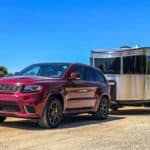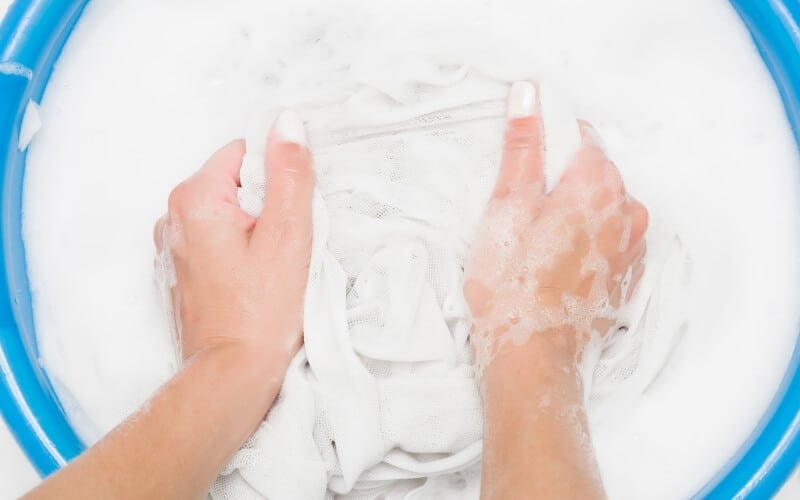Cold weather camping is a fact of life for many RVers. Especially for those of us who RV full-time, cold weather will inevitably join us on our journey.
Even though you can chase 70 degrees in an RV, sometimes the places you want to go to just won’t cooperate weather-wise.
And that’s why many folks opt to use RV skirting to keep their RV warm during the colder winter months.
But why use RV skirting?
Skirting your RV is the best way to keep your RV’s water pipes from freezing when the weather turns cold. It is a type of protective barrier cover the underbelly of your camper and keep cold gusts from blowing underneath your rig. Cold winds under your RV are one of the biggest contributors to cold temps inside. By blocking winds with an RV skirt, you’ll help create warm temperatures inside your camper.
In this article, we’ll unpack when and why you would use RV skirting, the types of RV skirting out there, and how to decide if you should DIY or buy RV skirting for your rig.
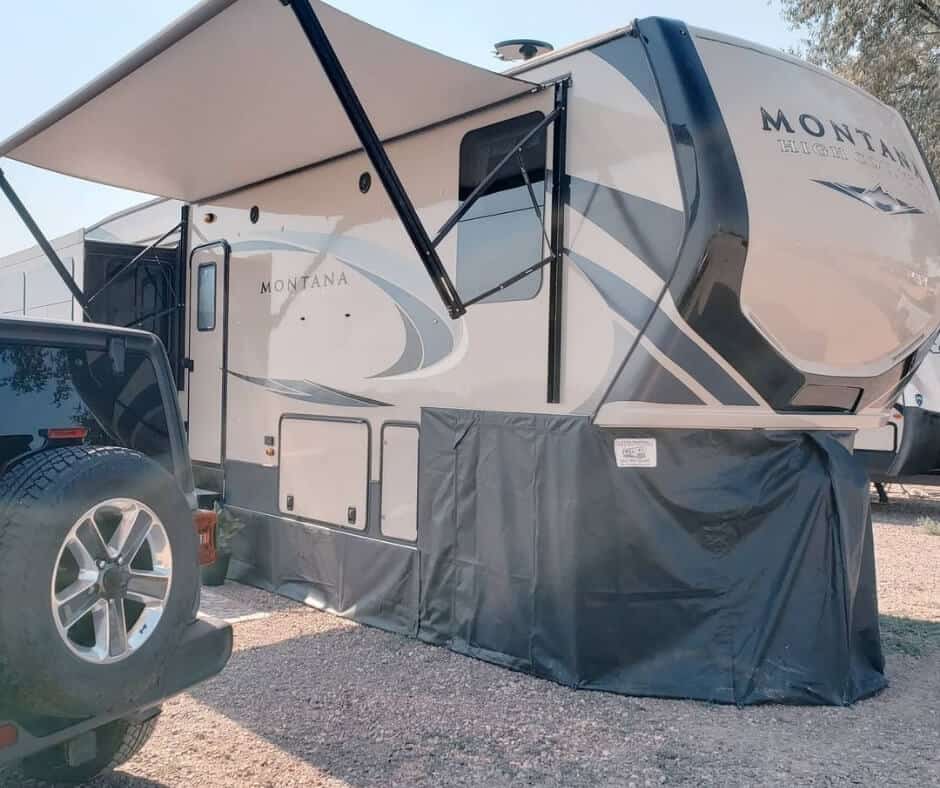
What Is RV Skirting?
RV skirting is simply an airtight wrap you put all around the underside of your camper to prevent cold winds from blowing along the underbelly of your camper.
If cold winds regularly blow along your RV’s underbelly, this will create cold temperatures inside your RV and (even worse) cause your plumbing system to freeze.
So, if you plan to full-time or long-term RV in an area where temps regularly dip below freezing, RV skirting becomes important for you.
Does RV Skirting Work?
Yes! Cold or freezing winds blowing along the underside of your RV are one of the biggest contributors to cold interior temps and frozen RV pipes.
By putting up RV skirting in the right way, you’ll block those winds and offer significant cold weather protection in your RV.
How Much Does RV Skirting Cost?
The costs of RV skirting vary greatly depending on the size of your rig and, more importantly, what type of skirting you decide to use.
If you DIY your own RV skirting (more on that below) it can cost you between $100-$500 depending on the type of materials you use and how you source them.
DIY RV skirts may be one-time use only, meaning you’ll spend money each year re-skirting your RV.
If you use a professionally made RV skirt or have one installed, expect to spend anywhere from $1,000-$5,000 to skirt your RV.
Professional RV skirts are usually designed to be reused year after year. Because of that, professional RV skirts can be used over and over again for one price.
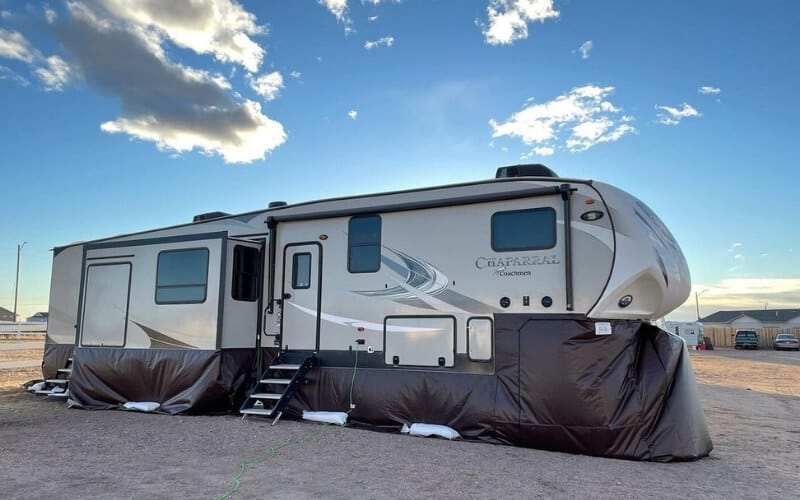
When You Need RV Skirting?
You’ll should use RV skirting anytime you’re camping long-term in freezing temperatures — especially in areas where high winds are common.
It is also important to use RV skirting if you are in a camper that is not four-season. Four-season campers usually have heated underbellies and water tanks that are resistant to freezing.
Because campers that are not four-season don’t have this protection, it becomes necessary to skirt their undersides in freezing weather.
This helps prevent pipes and tanks from freezing — along with keeping you and yours warm in the camper.
Lastly, you might want to use RV skirting in areas where there are high winds and lots of dust, sand, or dirt that would be blowing around.
In these cases, it might not be cold, but it still pays to protect your RV’s underside from this stuff.
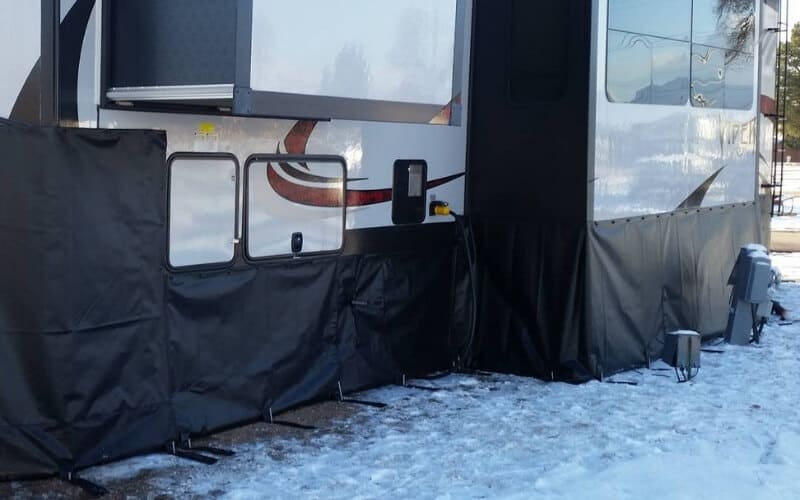
How To Skirt Your RV In The Winter
Skirting your RV in the winter can be a very large job that is tough to DIY unless you have a great deal of skill with finding the right materials, making exacting measurements, and then cutting and installing your skirt so it’s airtight.
That said, you have three options when it comes to skirting your RV for the winter:
-
DIY it completely — In this scenario, you find the materials yourself (see below for different types of RV skirting materials), take all the measurements along the underbelly of your RV, cut your materials to fit and then attach the skirt to your RV.
-
Order a kit — Kits like the EZ snap come with all the materials you need to DIY your own RV skirt. You’ll still have to do the work, make some measurements, do some cutting, and install the skirt — but the kit will ensure you have everything you need for the job.
-
Order a custom RV skirt — Companies like rvskirting.com will fully customize and personally install your RV skirt. This is the most expensive option, but it’s also the one that would ensure the best fit and create an RV skirt that you could reuse over and over again.
What Types Of RV Skirting Can I Use?
There are many different types of RV skirting materials out there. There are also many options for purchase along with DIY options.
The material you use will depend on the weather in the area you want to camp, your budget, and your level of skill with DIYing an RV skirt.
Here are the types of RV skirting material you can consider and the pros and cons of each:
1. Custom vinyl skirting
This is when a company actually customizes a skirt to fit your RV like a glove.
They’ll take detailed measurements, source high quality new materials, and create an RV skirt for you that’ll be reusable season after season.
PROS
CONS
2. Self installed vinyl skirting
Rather than ordering a custom vinyl RV skirt, you can source, measure and cut one yourself. While a budget friendly option, this does demand a high level of skill.
PROS
CONS
3. Inflatable skirting
Rather than fastening to your RV, this type of RV skirting stays in place by putting pressure on your camper.
PROS
CONS
4. Windskirts
Windskirts like these can be used when RVing in areas that are not extremely cold but when some protection is needed from freezing.
Windskirts are a simpler option that were primarily designed for areas with high winds and blowing dust.
PROS
CONS
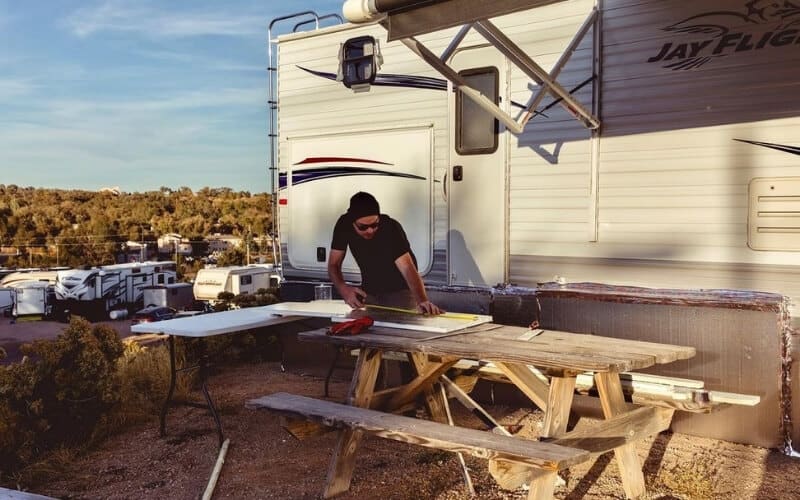
Should I DIY My RV Skirting?
You can DIY your own RV skirting, but it can be very time consuming and requires a great deal of skill to get the measurements and cutting right so that it looks good.
When it comes to DIYing your RV skirting, you can build it from scratch with materials you find (e.g. vinyl, plywood, foam, etc.) or you can buy a kit like this one that will come with materials and require you to DIY the rest.
If you choose to completely DIY your RV skirting, the chances are also good that you’ll wind up with an RV skirt that will be one-time use.
Foamboard, for example, is a popular material for RV skirting, but is generally not good for multiple uses.
Here are other examples of materials you can use for RV skirting:
Hay bales
If you find yourself in farm country, you’ll likely have access to an abundant supply of hay bales.
RVers will often DIY an RV skirt by tucking hay bales all around their camper to create a tight seal around the underbelly.
Caution: While using hay bales as RV skirting will provide terrific cold weather protection, hay bales also attract rodents and other creatures that can make their way into your RV.
There is also a chance that using hay bales in this way could cause a fire due to the heat it generates under your RV.
Reflectix skirting
Reflectix is that silver bubble looking stuff that is commonly used by RVers to cover windows in cold weather.
Reflectix works great as DIY RV skirting material because it’s easy to measure and cut, traps heat well, and is affordable.
The one major drawback of Reflectix is that it is not attractive as an RV skirt. In fact, many RV parks won’t let you skirt your camper with Reflectix because of the way it looks.
One way around this would be to wrap the Reflectix in a material that is more visually appealing, but that adds a good deal of work and cost to your project.
Plywood/particle board
Many RVers DIY a skirt using plywood combined with insulation fastened to the back.
While this process is very time consuming, it can be completed with readily available and affordable materials.
Plywood alone won’t be visually attractive as an RV skirt unless you paint it.
One of the benefits of plywood is that it’s relatively easy to affordably paint it so your RV skirt fits in at even the most sensitive of RV parks.
Foam board insulation
This is a commonly used material for DIY RV skirting that is easy to find, affordable, and relatively easy to work with.
However, there is almost no way to make foam board insulation look good, so unless your RV is parked in an inconspicuous location, this will likely not be a good option.
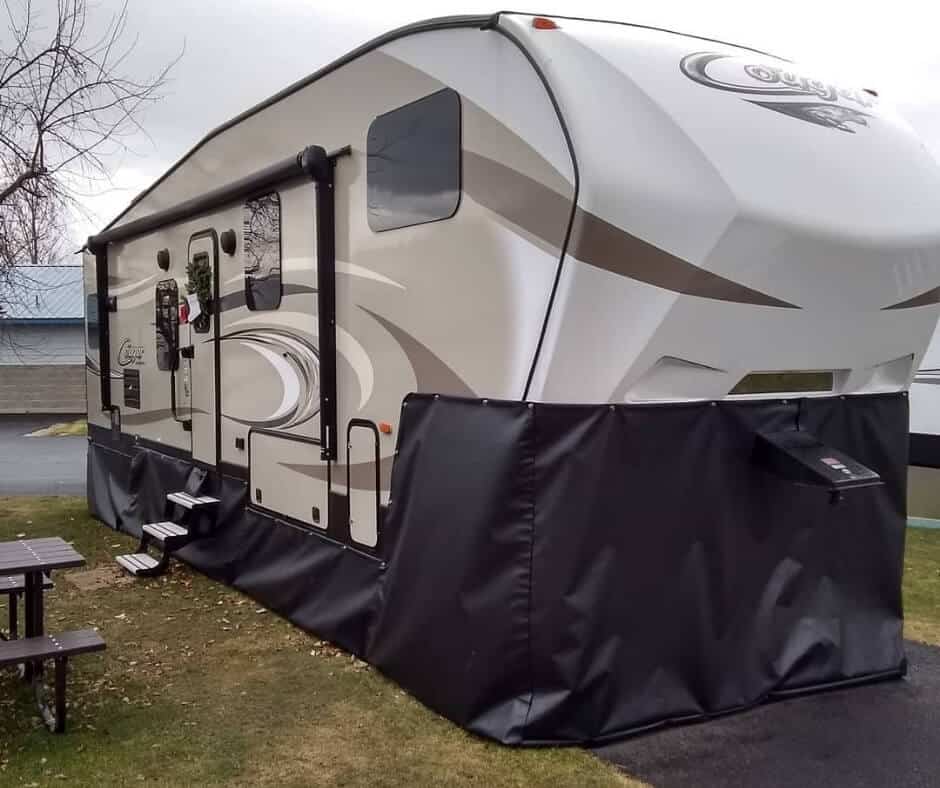
Best Skirting for Fifth Wheels
If you have a fifth-wheel camper, all of the above concepts for RV skirting will apply to you with one exception.
If you are DIYing or buying a kit to DIY an RV skirt for your fifth-wheel, you will be best served by purchasing a 5TH Wheel Skirt to cover up the front portion of your fifth-wheel (where the hitch is) while also creating doors for you to get into that part of your camper.
Conclusion
If you’ve ever seen an RV with a skirt on it, you might have wondered why you’d use RV skirting. As you now know, RV skirting is one of the best ways to keep your rig warm in the winter.
So, if you find yourself in cold weather while living in an RV, RV skirting can be worth considering.
The key questions then become whether you’ll DIY your RV skirt or hire a professional, what materials you want your RV skirt to me made of, and how easy you want it to be to remove and replace the RV skirt each season.
Last Updated on March 16, 2021 by Aaron Richardson


